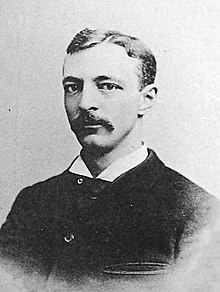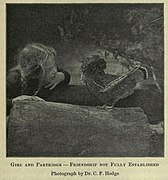
Clifton Fremont Hodge (16 October 1859 – 1949) was an American professor of physiology who worked at Clark University. An educator and a keen experimental biologist, he took great interest in natural history, animal behavior, and public understanding of biology, taking an active role in public debates on vivisection, experimentation on animals, conservation, and evolution. He opposed a bounty offered for specimens of the last few passenger pigeons which was eventually withdrawn. His textbook Civic Biology (1919) was the last biology text dealing with evolution before the anti-evolution movement began in 1920.
Biography
Hodge was born in Janesville, Wisconsin on 16 October 1859 to Mary (Merrill) and Nelson Wellington. He graduated with a BA from Ripon College in 1882, and worked as a civil engineer in Montana and Wyoming before joining Johns Hopkins University in 1886. Receiving a Ph.D. in 1889 he also worked in the university museum as a curator and was a fellow in biology. He worked as a naturalist on the USFC Fish Hawk and then joined Clark University where he worked on neurobiology while also promoting biological education at all levels including sex education in high schools. He demonstrated fatigue in nerve cells by continuous stimulation of sympathetic and spinal ganglia of frogs. He conducted experiments on the effect of alcohol to cats and dogs. He then moved to the University of Wisconsin. From 1913 he served as professor of biology at the University of Oregon. He studied problems related to nuisance insects and worked on efficient traps.
Hodge was an advocate of animal experiments and opposed the arguments of anti-vivisectionists. In 1896, he commented that "after conscientiously reading their literature for the past five years I feel warranted in saying that science has little to fear from the efforts of the antivivisection societies." His textbook Civic Biology (1919) coauthored with Jean Dawson (who was later his wife) was among the last pro-evolution texts to be published prior to the 1920s anti-Darwinian movement.
He became a professor of extension at the University of Florida around 1919, taking an interest in applied biology, including local problems relating to flies and mosquitoes.

Hodge was a keen naturalist, outdoors educator, and a member of the American Ornithologists' Union (AOU). At the 1909 meeting of the AOU he raised issue with the $100 reward being offered by Colonel Anthony Kuser for fresh specimens of the passenger pigeon and stated that he would not shoot a pigeon for even $1000. Kuser subsequently changed the reward to $300 for evidence of breeding. Hodge was also interested in animal as well as human behavior and introduced the idea of the ball and field test which was developed by his student Lewis M. Terman more formally and used in psychology studies. He examined how animals navigated their habitat and was critical of any suggestions of unknown senses and suggested rigorous experimental approaches. He wrote that "All animals, from amoeba to man, spend a good share of their time searching for something or other. May there not be a fundamental logic of search as universal as the search itself?. . . What is the path or curve of logical search?" and experimented on animal and human search strategies. Hodge examined homing pigeons and noted that there was learning involved in their homing. He also attempted to domesticate ruffed grouse and raised bobwhite quails. He influenced the ornithologist Margaret Morse Nice.
Personal life
He married Thekla Johanna Eversz (1858–1930), of Wesel, Germany in 1888 and they had two children. He married Jean Dawson (1872-24 April 1928) in 1915 and settled in Sebring, Florida where he died.
Selected publications
- The Bobwhite (1890)
- A Microscopical Study of Changes Due to Functional Activity in Nerve Cells (1892)
- The Vivisection Question (1896)
- Experiments on the Physiology of Alcohol Made Under the Auspices of the Committee of Fifty (1897)
- Nature Study. Our Common Birds. (1899)
- Nature Study and Life (1902)
- Civic Biology (1918)
References
- ^ Johnson, Rossiter; Brown, J.H., eds. (1906). The Biographical Dictionary of America. Volume 5. Boston: American Biographical Society. p. 307.
- Hodge, C. F. (1911). "Instruction in social hygiene in the public schools". School Science and Mathematics. 11 (4): 304–314. doi:10.1111/j.1949-8594.1911.tb03377.x.
- Fish, Pierre A. (1898). "The Nerve cell as a unit". The Journal of Comparative Neurology. 8 (1–2): 99–110. doi:10.1002/cne.910080107. S2CID 84616895.
- Hodge, C. F. (1891). "The Process of Recovery from the Fatigue Occasioned by the Electrical Stimulation of Cells of the Spinal Ganglia". The American Journal of Psychology. 3 (4): 530–543. doi:10.2307/1412062. ISSN 0002-9556. JSTOR 1412062.
- Hodge, C. F. (1894-08-13). "Changes in Ganglion Cells from Birth to Senile Death. Observations on Man and Honey-Bee". The Journal of Physiology. 17 (1–2): 128–134. doi:10.1113/jphysiol.1894.sp000522. PMC 1514580. PMID 16992203.
- Hodge, C. F. (1889). "Some Effects of Electrically Stimulating Ganglion Cells". The American Journal of Psychology. 2 (3): 376–402. doi:10.2307/1411955. ISSN 0002-9556. JSTOR 1411955.
- Hodge, C. F. (1897). "Action of alcohol on dogs as regards non-viability and malformation of the young, and severity of attack in an epidemic of distemper". Journal of the Boston Society of Medical Sciences. 2 (4): 35–38. PMC 2121773. PMID 19971161.
- Hodge, C. F. (1913). "The distance house flies, blue bottles and stable flies may travel over water". Science. 38 (980): 512–513. Bibcode:1913Sci....38..512H. doi:10.1126/science.38.980.512-a. ISSN 0036-8075. PMID 17813652. S2CID 31084105.
- Hodge, C. F. (1913). "A new fly trap". J. Econ. Entomol. 6: 110–112. doi:10.1093/jee/6.1.110.
- Hodge, Clifton F. (1896). The Vivisection Question. New York: D. Appleton and Company. p. 26.
- Larson, E. J. (1987). "Before the crusade: Evolution in American secondary education before 1920". Journal of the History of Biology. 20: 89–114. doi:10.1007/BF00125259. S2CID 84235193.
- Smith, Kimberly G. (2010). "100 Years Ago". The Auk. 127 (4): 964–965. doi:10.1525/auk.2010.127.4.964. S2CID 198153219.
- Brooks, Katherine (1917). "Flies toward the light". Florida Health Notes. 12 (1): 12–13.
- Hodge, C.F. (1920). "The mosquito-malaria problem in Florida". The Florida Entomologist. 4 (1): 1–6. doi:10.2307/3492726. JSTOR 3492726.
- Hodge, C. F. (1908). "College biology in relation to training of teachers". Nature Study Review. 4: 193–196.
- Johnson, George Ellsworth (1907). Education by plays and games. Ginn and Company.
- Greenberg, Joel (2014). A Feathered River Across the Sky: The Passenger Pigeon's Flight to Extinction. Bloomsbury Publishing. pp. 174–176.
- Hodge, C. F. (1910). "To save the Passenger Pigeon". Forest and Stream. 74: 172.
- Hodge, C. F. (1912). "A last word on the Passenger Pigeon" (PDF). Auk. 29 (2): 169–175. doi:10.2307/4071351. JSTOR 4071351.
- Hodge, C. F.; Aikins, Herbert Austin (1895). "The Daily Life of a Protozoan: A Study in Comparative Psycho-Physiology". The American Journal of Psychology. 6 (4): 524–533. doi:10.2307/1411190. ISSN 0002-9556. JSTOR 1411190.
- Hodge, C. F. (1890). "A Sketch of the History of Reflex Action. II. Bell's Law". The American Journal of Psychology. 3 (3): 343–363. doi:10.2307/1411698. ISSN 0002-9556. JSTOR 1411698.
- Hodge, C. F. (1890). "A Sketch of the History of Reflex Action: I. Beginnings and Development to the Time of Charles Bell". The American Journal of Psychology. 3 (2): 149–167. doi:10.2307/1411089. ISSN 0002-9556. JSTOR 1411089.
- ^ Littman, R. A. (2004). "Mental tests and fossils". Journal of the History of the Behavioral Sciences. 40 (4): 423–431. doi:10.1002/jhbs.20044. PMID 15378562.
- Hodge, C. F. (1894). "Method of homing pigeons". Popular Science Monthly. 44: 758–775.
- Ripon College. Alumni Catalogue 1867-1888. 1888. p. 21.
- "Necrology". The Michigan Alumnus: 324. 18 March 1950.



